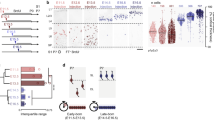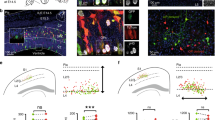Abstract
The molecular mechanisms that control how progenitors generate distinct subtypes of neurons, and how undifferentiated neurons acquire their specific identity during corticogenesis, are increasingly understood. However, whether postmitotic neurons can change their identity at late stages of differentiation remains unknown. To study this question, we developed an electrochemical in vivo gene delivery method to rapidly manipulate gene expression specifically in postmitotic neurons. Using this approach, we found that the molecular identity, morphology, physiology and functional input-output connectivity of layer 4 mouse spiny neurons could be specifically reprogrammed during the first postnatal week by ectopic expression of the layer 5B output neuron–specific transcription factor Fezf2. These findings reveal a high degree of plasticity in the identity of postmitotic neocortical neurons and provide a proof of principle for postnatal re-engineering of specific neural microcircuits in vivo.
This is a preview of subscription content, access via your institution
Access options
Subscribe to this journal
Receive 12 print issues and online access
$209.00 per year
only $17.42 per issue
Buy this article
- Purchase on Springer Link
- Instant access to full article PDF
Prices may be subject to local taxes which are calculated during checkout






Similar content being viewed by others
References
Lefort, S., Tomm, C., Sarria, J.C.F. & Petersen, C.C.H. The excitatory neuronal network of the C2 barrel column in mouse primary somatosensory cortex. Neuron 61, 301–316 (2009).
Petreanu, L., Mao, T., Sternson, S.M. & Svoboda, K. The subcellular organization of neocortical excitatory connections. Nature 457, 1142–1145 (2009).
Brown, S.P. & Hestrin, S. Intracortical circuits of pyramidal neurons reflect their long-range axonal targets. Nature 457, 1133–1136 (2009).
Yoshimura, Y., Dantzker, J.L.M. & Callaway, E.M. Excitatory cortical neurons form fine-scale functional networks. Nature 433, 868–873 (2005).
Schubert, D., Kötter, R. & Staiger, J.F. Mapping functional connectivity in barrel-related columns reveals layer- and cell type–specific microcircuits. Brain Struct. Funct. 212, 107–119 (2007).
Molnár, Z. & Cheung, A.F.P. Towards the classification of subpopulations of layer V pyramidal projection neurons. Neurosci. Res. 55, 105–115 (2006).
Molyneaux, B.J., Arlotta, P., Hirata, T., Hibi, M. & Macklis, J.D. Fezl is required for the birth and specification of corticospinal motor neurons. Neuron 47, 817–831 (2005).
Chen, J.-G., Rasin, M.-R., Kwan, K.Y. & Sestan, N. Zfp312 is required for subcortical axonal projections and dendritic morphology of deep-layer pyramidal neurons of the cerebral cortex. Proc. Natl. Acad. Sci. USA 102, 17792–17797 (2005).
Han, W. et al. TBR1 directly represses Fezf2 to control the laminar origin and development of the corticospinal tract. Proc. Natl. Acad. Sci. USA 108, 3041–3046 (2011).
Weimann, J.M. et al. Cortical neurons require Otx1 for the refinement of exuberant axonal projections to subcortical targets. Neuron 24, 819–831 (1999).
Sperry, R. Effect of 180 degree rotation of the retinal field on visuomotor coordination. J. Exp. Zool. 92, 263–279 (1943).
Van der Loos, H. & Woolsey, T.A. Somatosensory cortex: structural alterations following early injury to sense organs. Science 179, 395–398 (1973).
Sur, M., Garraghty, P.E. & Roe, A.W. Experimentally induced visual projections into auditory thalamus and cortex. Science 242, 1437–1441 (1988).
Hensch, T.K. Critical period plasticity in local cortical circuits. Nat. Rev. Neurosci. 6, 877–888 (2005).
Martinez-Cerdeño, V. et al. Embryonic MGE precursor cells grafted into adult rat striatum integrate and ameliorate motor symptoms in 6-OHDA–lesioned rats. Cell Stem Cell 6, 238–250 (2010).
Czupryn, A. et al. Transplanted hypothalamic neurons restore leptin signaling and ameliorate obesity in db/db mice. Science 334, 1133–1137 (2011).
Molyneaux, B.J., Arlotta, P., Menezes, J.R.L. & Macklis, J.D. Neuronal subtype specification in the cerebral cortex. Nat. Rev. Neurosci. 8, 427–437 (2007).
Barnabé-Heider, F. et al. Genetic manipulation of adult mouse neurogenic niches by in vivo electroporation. Nat. Methods 5, 189–196 (2008).
Lowery, R.L. et al. Rapid, long-term labeling of cells in the developing and adult rodent visual cortex using double-stranded adeno-associated viral vectors. Dev. Neurobiol. 69, 674–688 (2009).
Staiger, J.F. et al. Functional diversity of layer IV spiny neurons in rat somatosensory cortex: quantitative morphology of electrophysiologically characterized and biocytin labeled cells. Cereb. Cortex 14, 690–701 (2004).
Lübke, J., Egger, V., Sakmann, B. & Feldmeyer, D. Columnar organization of dendrites and axons of single and synaptically coupled excitatory spiny neurons in layer 4 of the rat barrel cortex. J. Neurosci. 20, 5300–5311 (2000).
Chen, B., Schaevitz, L.R. & McConnell, S.K. Fezl regulates the differentiation and axon targeting of layer 5 subcortical projection neurons in cerebral cortex. Proc. Natl. Acad. Sci. USA 102, 17184–17189 (2005).
Vandenbroucke, R.E., Lucas, B., Demeester, J., De Smedt, S.C. & Sanders, N.N. Nuclear accumulation of plasmid DNA can be enhanced by non-selective gating of the nuclear pore. Nucleic Acids Res. 35, e86 (2007).
Matsuda, T. & Cepko, C.L. Controlled expression of transgenes introduced by in vivo electroporation. Proc. Natl. Acad. Sci. USA 104, 1027–1032 (2007).
De Marco García, N.V., Karayannis, T. & Fishell, G. Neuronal activity is required for the development of specific cortical interneuron subtypes. Nature 472, 351–355 (2011).
Madisen, L. et al. A robust and high-throughput Cre reporting and characterization system for the whole mouse brain. Nat. Neurosci. 13, 133–140 (2010).
Jabaudon, D., Shnider, S.J., Tischfield, D.J., Galazo, M.J. & Macklis, J. D. RORß induces barrel-like neuronal clusters in the developing neocortex. Cereb. Cortex 22, 996–1006 (2012).
Nakagawa, Y. & O'Leary, D.D.M. Dynamic patterned expression of orphan nuclear receptor genes RORalpha and RORbeta in developing mouse forebrain. Dev. Neurosci. 25, 234–244 (2003).
Nieto, M. et al. Expression of Cux-1 and Cux-2 in the subventricular zone and upper layers II–IV of the cerebral cortex. J. Comp. Neurol. 479, 168–180 (2004).
Alcamo, E.A. et al. Satb2 regulates callosal projection neuron identity in the developing cerebral cortex. Neuron 57, 364–377 (2008).
Britanova, O. et al. Satb2 is a postmitotic determinant for upper-layer neuron specification in the neocortex. Neuron 57, 378–392 (2008).
Yoneshima, H. et al. Er81 is expressed in a subpopulation of layer 5 neurons in rodent and primate neocortices. Neuroscience 137, 401–412 (2006).
Arlotta, P. et al. Neuronal subtype–specific genes that control corticospinal motor neuron development in vivo. Neuron 45, 207–221 (2005).
Lai, T. et al. SOX5 controls the sequential generation of distinct corticofugal neuron subtypes. Neuron 57, 232–247 (2008).
Kwan, K.Y. et al. SOX5 postmitotically regulates migration, postmigratory differentiation, and projections of subplate and deep-layer neocortical neurons. Proc. Natl. Acad. Sci. USA 105, 16021–16026 (2008).
Inda, M.C., DeFelipe, J. & Muñoz, A. Voltage-gated ion channels in the axon initial segment of human cortical pyramidal cells and their relationship with chandelier cells. Proc. Natl. Acad. Sci. USA 103, 2920–2925 (2006).
Connors, B.W. & Gutnick, M.J. Intrinsic firing patterns of diverse neocortical neurons. Trends Neurosci. 13, 99–104 (1990).
Andjelic, S. et al. Glutamatergic nonpyramidal neurons from neocortical layer VI and their comparison with pyramidal and spiny stellate neurons. J. Neurophysiol. 101, 641–654 (2009).
Sheets, P.L. et al. Corticospinal-specific HCN expression in mouse motor cortex: Ih-dependent synaptic integration as a candidate microcircuit mechanism involved in motor control. J. Neurophysiol. 106, 2216–2231 (2011).
Narboux-Nême, N. et al. Neurotransmitter release at the thalamocortical synapse instructs barrel formation, but not axon patterning in the somatosensory cortex. J. Neurosci. 32, 6183–6196 (2012).
Viaene, A.N., Petrof, I. & Sherman, S.M. Synaptic properties of thalamic input to the subgranular layers of primary somatosensory and auditory cortices in the mouse. J. Neurosci. 31, 12738–12747 (2011).
Petreanu, L., Huber, D., Sobczyk, A. & Svoboda, K. Channelrhodopsin-2–assisted circuit mapping of long-range callosal projections. Nat. Neurosci. 10, 663–668 (2007).
Putignano, E. et al. Developmental downregulation of histone post-translational modifications regulates visual cortical plasticity. Neuron 53, 747–759 (2007).
Mohn, F. et al. Lineage-specific polycomb targets and de novo DNA methylation define restriction and potential of neuronal progenitors. Mol. Cell 30, 755–766 (2008).
Kim, J., Ambasudhan, R. & Ding, S. Direct lineage reprogramming to neural cells. Curr. Opin. Neurobiol. 22, 778–784 (2012).
Callaway, E.M. & Borrell, V. Developmental sculpting of dendritic morphology of layer 4 neurons in visual cortex: influence of retinal input. J. Neurosci. 31, 7456–7470 (2011).
Cubelos, B. et al. Cux1 and Cux2 regulate dendritic branching, spine morphology and synapses of the upper layer neurons of the cortex. Neuron 66, 523–535 (2010).
Terashima, T., Inoue, K., Inoue, Y., Mikoshiba, K. & Tsukada, Y. Distribution and morphology of callosal commissural neurons within the motor cortex of normal and reeler mice. J. Comp. Neurol. 232, 83–98 (1985).
Lörincz, A., Notomi, T., Tamás, G., Shigemoto, R. & Nusser, Z. Polarized and compartment-dependent distribution of HCN1 in pyramidal cell dendrites. Nat. Neurosci. 5, 1185–1193 (2002).
Flames, N. & Hobert, O. Gene regulatory logic of dopamine neuron differentiation. Nature 458, 885–889 (2009).
Liashkovich, I., Meyring, A., Kramer, A. & Shahin, V. Exceptional structural and mechanical flexibility of the nuclear pore complex. J. Cell. Physiol. 226, 675–682 (2011).
Berndt, A. et al. High-efficiency channelrhodopsins for fast neuronal stimulation at low light levels. Proc. Natl. Acad. Sci. USA 108, 7595–7600 (2011).
Toni, N. et al. Neurons born in the adult dentate gyrus form functional synapses with target cells. Nat. Neurosci. 11, 901–907 (2008).
Bannister, N.J. et al. Developmental changes in AMPA and kainate receptor–mediated quantal transmission at thalamocortical synapses in the barrel cortex. J. Neurosci. 25, 5259–5271 (2005).
Daw, M.I., Bannister, N.V. & Isaac, J.T. Rapid, activity-dependent plasticity in timing precision in neonatal barrel cortex. J. Neurosci. 26, 4178–4187 (2006).
Acknowledgements
We thank G. Fishell (New York University) for the gift of the Dlx5/6 plasmid, C.L. Cepko (Harvard University) for the pCAGIG_IRES_GFP and pCAG_ERT2-CRE-ERT2 plasmids, and B. Sauer (US National Institutes of Health) for the pBS302_STOP plasmid, obtained through Addgene. We are thankful to E. Azim and A. Dayer for helpful comments on the manuscript, and to A. Zimmerman and F. Smets for help with the experiments. We thank B. Cerutti for help with the statistical analysis. C.B. is supported by an Ambizione grant from the Swiss National Science Foundation. C.L. is supported by the Swiss National Science Foundation. The Jabaudon laboratory is supported by the Swiss National Science Foundation (PP00P3-123447), the Velux Foundation, the 3R Foundation and the Brain and Behavior Research Foundation. N.T. and J.M. are supported by the Swiss National Science Foundation (PP00A-119026). D.J. and N.T. are supported by a joint Leenaards Foundation for Scientific Research Award.
Author information
Authors and Affiliations
Contributions
D.J. and A.D.l.R. conceived the project and designed the experiments, D.J. and C.B. designed the electrophysiological experiments, and A.D.l.R., C.B., B.G., J.M., N.T. and I.V. performed the experiments. D.J., A.D.l.R., C.B. and C.L. wrote the manuscript.
Corresponding author
Ethics declarations
Competing interests
The authors declare no competing financial interests.
Supplementary information
Supplementary Text and Figures
Supplementary Figures 1–5 (PDF 4832 kb)
Rights and permissions
About this article
Cite this article
De la Rossa, A., Bellone, C., Golding, B. et al. In vivo reprogramming of circuit connectivity in postmitotic neocortical neurons. Nat Neurosci 16, 193–200 (2013). https://doi.org/10.1038/nn.3299
Received:
Accepted:
Published:
Issue Date:
DOI: https://doi.org/10.1038/nn.3299
This article is cited by
-
A Spacetime Odyssey of Neural Progenitors to Generate Neuronal Diversity
Neuroscience Bulletin (2023)
-
Neuroplasticity related to chronic pain and its modulation by microglia
Inflammation and Regeneration (2022)
-
Transcription factor 4 controls positioning of cortical projection neurons through regulation of cell adhesion
Molecular Psychiatry (2021)
-
Uncovering Statistical Links Between Gene Expression and Structural Connectivity Patterns in the Mouse Brain
Neuroinformatics (2021)
-
Overcoming Current Dilemma in Cartilage Regeneration: Will Direct Conversion Provide a Breakthrough?
Tissue Engineering and Regenerative Medicine (2020)



